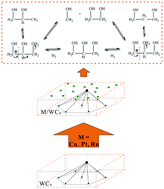Hydrogenolysis of glycerol has been a subject of intensive research in recent decades. Great efforts have been made investigating the mechanism of bond cleavage using metal or metallic oxide catalysts. In this work, effects of a series of WCx-based catalysts, including WCx, Cu/WCx, Pt/WCx, Ru/WCx, CuRu/WCx and CuPt/WCx, were studied on hydrogenolysis of glycerol to investigate the role of each active phase. WO3-Based catalysts were employed as a comparison with the WCx-based catalysts. Hydrogenolysis of model compounds (1,2-PDO and EG) of glycerol was also studied using these catalysts, in attempts to determine the mechanism of the whole reaction. The presence of metal elements on WCx or WO3 can significantly improve the conversion of reactant. In addition, the ability of WCx to promote cleavage of C–C was verified. Ru is more beneficial for formation of EG than Pt, whereas Pt is favorable for formation of 1,2-PDO. It had been supposed that hydrogenolysis of glycerol by WCx-based catalysts occurred via two different but overlapping routes: WCx-related reactions caused by C–C cleavage and metal-related reactions caused by C–O cleavage, which happen simultaneously in the reaction. The current study not only demonstrates that the catalytic performance of WCx can be manipulated by varying metal loading, but also offers a possible mechanism for C–C and C–O cleavage in hydrogenolysis of glycerol, which could be beneficial when focusing on the target product.

